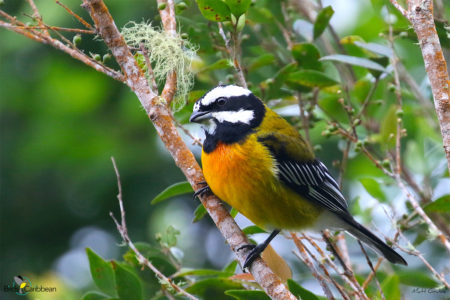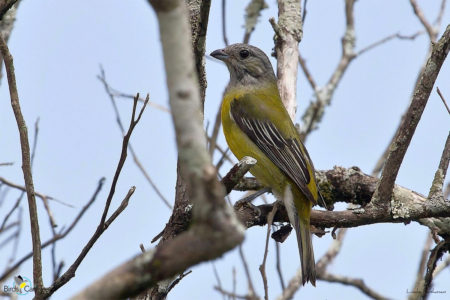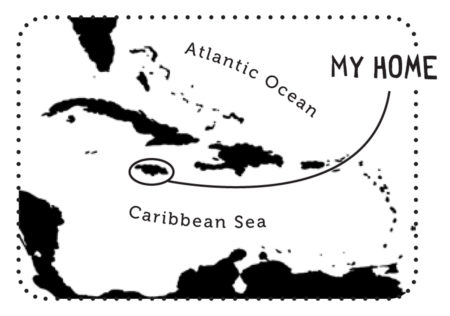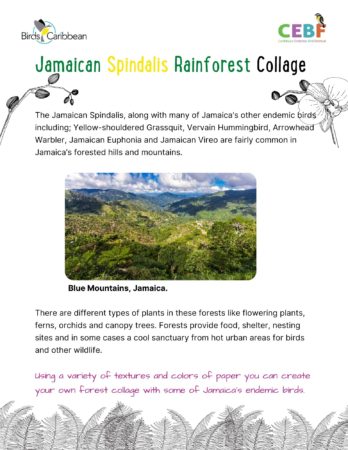Celebrate the Caribbean Endemic Bird Festival (CEBF) with us! Our theme in 2021 is “Sing, Fly, Soar—Like a Bird!” Have fun learning about a new endemic bird every day. We have colouring pages, puzzles, activities, and more. Download for free and enjoy nature with your family at home.
Endemic Bird of the Day: Jamaican Spindalis
When you set eyes on a male Jamaican Spindalis (Spindalis nigricephala), you cannot help but admire this spectacular endemic. The vivid black-and-white stripes on his head give him one of his local names — “Mark Head.” He has a brilliant yellowish-orange breast that becomes yellow on the belly, and a white lower belly and undertail. His yellow-olive back fades into yellowish-orange on the rump. The black feathers on his wings and tail are edged with white.
What’s the difference between male and female? This species is “sexually dimorphic,” meaning that males and females look different from each other. As is often the case, the female is less colorful – she is the dull one! She has an olive back, a greenish-yellow breast and belly that fades to pale yellow, and a grayish-olive head and throat. Like the male, she has a white undertail and white-edged wing feathers, but she lacks those bright stripes on her face.
The thin, high-pitched call “tsee” of the Jamaican Spindalis is a common sound in Jamaican forests, and might be your first (or only) hint that one is nearby. It also gives a soft, weak “seep” in flight. While foraging in groups, individuals may give a fast, high “chi-chi-chi-chi-chi.” From an exposed perch, a male will sing a song that consists of a long-sustained phrase repeated several times — “chu wheet, chee see whee see, chu wheet.” These distinct sounds have inspired another popular local name, “Champa Beeza.”
The Jamaican Spindalis roams through forests, woodlands, and brushy areas in the hills and mountains, searching for fruiting trees. Some of their favorites include ficus, pimentos (allspice), palms, cecropia, and oranges. They will also consume nectar, blossoms, leaves, and the occasional insect. You might meet them in pairs and family groups, but you can also find them in flocks with different species.
This agile bird is often seen hanging from twigs and leaves to take berries, or even using its bills to swing effortlessly between plants. Despite these impressive moves, it can only perform short-distance flights, which limits its habitat to forest and forest edges. To protect the Jamaican Spindalis, it is important to conserve and connect habitat, including the preservation of large canopy trees in an ever-changing urban landscape. Learn more about this species, including its range, photos, and calls here.
Colour in the Jamaican Spindalis
Download our West Indies Endemic Bird colouring page. Use the photos below as your guide, or you can look up pictures of the bird online or in a bird field guide if you have one. Share your coloured-in page with us by posting it online and tagging us @BirdsCaribbean #CEBFfromthenest
Listen to the call of the Jamaican Spindalis
The call of the Jamaican Spindalis is a high-pitched “tsee,” sometimes alone sometime repeated in quick succession.
Puzzle of the Day
Click on the image below to do the puzzle. You can make the puzzle as easy or as hard as you like – for example, 6, 8, or 12 pieces for young children, all the way up to 1,024 pieces for those that are up for a challenge!


Activity of the Day
FOR KIDS: The Jamaican Spindalis, along with many other Caribbean endemic birds found on Jamaica, like the Yellow-shouldered Grassquit, Vervain Hummingbird, Arrowhead Warbler, Jamaican Euphonia and Jamaican Vireo love to live in and around the forests of Jamaica’s hills and mountains. In fact birds across the Caribbean rely on forests as places to nest, feed, rest and shelter. Forests in the Caribbean contain many different types of plants such as, ferns, orchids, other flowering plants and canopy trees. Forests also provide homes for many other types of wildlife as well as birds and plants! Using a variety of textures and colours of paper create your own forest collage with some of Jamaica’s endemic birds! Download our instructions here including some helpful silhouettes and shapes to get you started. You can get an adult to help you with any cutting out.
FOR KIDS AND ADULTS: Read all about how Goat Island, one of the homes of today’s featured bird, the Jamaican Spindalis, and many other Jamaican and Caribbean endemic birds was saved from what would have been a catastrophic development. Then read about the plans to make the same area a Wildlife Sanctuary!
Enjoy these videos below of Jamaican Spindalis in the wild! In the first video you can see a female Spindalis, filmed in the Blue Mountains of Jamaica. The second video shows the more strikingly coloured male, feeding on some flowers.



